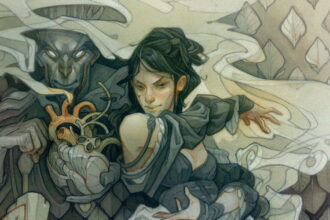The Barbarian Class, Part One

Today I realized that it’s been almost three years since my last History of the Classes article. Today I’m starting in on the Barbarian, a class that goes back to an article by E. Gary Gygax in Dragon Magazine #63, in July 1982. As a disclaimer for the whole series: “barbarian” is a culturally loaded word and is a slur from first principles. I’m not defending it. I would be fine with changing the class name to “berserker” so that we can have features named “My Love for You is Like a Truck.”
Dragon Magazine #63
The flavor text is quite brief, with little to differentiate them from rangers save a different alignment restriction (any non-lawful, rather than any good). This is a sub-class of fighters, but that doesn’t convey a lot of information – not their XP, not their Hit Die, not their number of proficiency slots, and definitely not the magic items they can use. It does tell you which combat matrix and saving throw progression to use.
(The organization of the article leaves… essentially everything to be desired, so I’m covering the rest of it in the order appearing.)
- They have no “major characteristics,” which seems to mean “prime requisite scores” – an excuse to give them no percentage XP bonuses. As we’ll see in a minute, that’s brutal given their XP requirements.
- No psionics for you.
- Their ability score generation is… hard for me to understand. Don’t you have to roll ability scores before you pick your class in AD&D 1e? Well, not here, that’s for sure – your ability scores are a class feature. You roll nine six-sided dice and keep the best three for Strength, then the best 3 of 7d6 for Dex and best 3 of 8d6 for Con. This is balanced (?) by only a normal 3d6 for Int, 4d4 for Wisdom (…ouch), and 3d6 for Charisma.
- What I think is going on here: I’m guessing that in his home table, Gary was using all kinds of different ability score generation methods to make it possible to hit high ability score requirements, and it peeked through here.
- The AC benefit that you gain from high Dex varies based on the armor you wear. Which means you need to know the difference between different armor bulk ratings, which are a DM Secret (that is, found in the DMG, p. 27). The three bulk ratings are “non,” “fairly,” and “bulky.” Anyway, in non-bulky armor, you get -2 AC per point of Dex above 14; otherwise, -1. Let me just crunch that math for you: elfin chain is the best armor, because of course it is. If you can’t get that, then plate is the best across all possible Dex scores. Leather armor +2 matches up to plate armor, if you have 18 Dex.
- You can trace a pretty straight line from this to Unarmored Defense in 5e, though I specifically like that Unarmored Defense isn’t better or worse than wearing armor across all possible ability scores.
- You also gain more hit points per point of Con over 14 than other classes. No tradeoff here, just some impressive survivability.
- Humans only. I don’t know why anyone would even think there could be a half-orc barbarian. What a risible concept.
- d12 HD (behold, a barbarian feature that has survived every incarnation that isn’t specifically a fighter kit!), a max of 8 HD (…weirdly low), but their first Hit Die can’t give them fewer than 7 hit points. No spells, and because they can only be humans, no class level limit, obviously.
- They can use any armor (the text pretends that you won’t want to wear fairly bulky or bulky armor, but that is a trap for people who are bad at math), any shield, and any weapon. They can use oil, and poison gets a “?” which… based on context elsewhere means “it’s up to the DM.”
- No magic items for you! Ever! Also, you can’t associate with magic-users, and clerics with higher-level spells are suspect! I have no idea how this was ever supposed to be fun or playable for anyone, since the barbarian’s player shouldn’t be allowed to tell other people what character classes are acceptable. I do think it’s funny that “the paladin is a jerk to the thief” is what people remember from 1e, and not “the barbarian bullies the nerds.” But also… all of the cool loot is useless to you, and you try to destroy it so no one else can enjoy it either! That’ll make for a fun game, right?
- This part is also blisteringly racist, from its presentation of superstition and its assertion that the character’s home culture wouldn’t have magic items, magic-users, or clerics of mid-level or higher.
- Base movement rate of 15” (compared to the normal 12”); it’s unclear how this interacts with the slowing effects of fairly bulky and bulky armor.
- Barbarians speak Common and their tribal language, don’t learn an alignment language, and have to learn to read and write rather than being literate as a baseline.
- Barbarians can climb walls as a thief of the same level and hide in shadows as a thief of three levels higher, if in a familiar terrain; otherwise their hiding skill is equal to a thief of their level. The implication that a barbarian has to spend time getting familiar with, you know, the idea of walls is pretty wild.
- I really wish the idea of “secondary skills” and “tertiary skills” had a coherent rules meaning. Anyway, the barbarian’s secondary skills are Survival, First Aid, Outdoor Craft (it’s what we’d now call the Nature skill), and Tracking (as a ranger of the same level). They’re restricted to outdoor tracking, because barbarians are unfamiliar with cave tunnels as well as walls. I like that there are rules of some sort about how to become familiar with a new region so that you can use these skills.
- Their tertiary skills are determined by their culture (see Native Territory, below). Possible tertiary skills include animal handling, horsemanship, long distance signaling (like the noted barbarians of… Gondor), running, small craft (paddled and rowed, separately), sound imitation, and trap building. These skills don’t get a success percentage or any other mechanical clarification.
- Special abilities and defenses. I mean, without magic items or buffs from casters, sure, you need a ton of extra stuff to survive!
- Surprise! It makes me absolutely crazy that the surprise rules are sometimes expressed as a percentage and sometimes as a d6 result – I can do the math, of course, but please for the love of Pelor be consistent. Anyway, barbarians surprise enemies more often – a 3 on a d6 in unfamiliar terrain, 4 in familiar. They are surprised by enemies 10% of the time (what?), or 5% in familiar terrain. So that shifts from a d6 to a d10 to I guess maybe a d20 or d100? Staaaaahp.
- Back Attack isn’t the ability to deliver a backstab, but the ability to downgrade one to a normal attack – a 5% chance per level; this also lets the barbarian retaliate as a free attack. This is interesting because it survives, in concept, all the way to 3.5e’s Improved Uncanny Dodge.
- Leaping and Springing – this is sort of the feat of the salmon-leap from the Irish legend cycle. The numbers used here for the distance you can leap (running start) or spring (no running start) are based on dice, but it’s expressed oddly.
- Detect Illusion, 5% per level, up to 75%. Nice to see that the antipathy toward magic has some benefit.
- Detect Magic, 20% + 5% per level, up to 90%. This doesn’t reveal magic-users in itself, but they might detect an active buff and figure them out that way.
- Finally we get the XP table. You reach 2nd level at 6,001 xp… by which point a standard fighter, ranger, or paladin are 3rd As a barbarian, you’ll spend your whole career being a level or two behind every other character at any given XP total. Also, your level title is “barbarian” at every level, and I’ve got to think that feels at least a little disappointing. Always the barbarian, never the king of Aquilonia, reigning supreme in the dreaming west.
- You gain extra attacks per round at what I think is the same rate as a non-specialized fighter, though I’m having an awful time finding the fighter’s progression table right now. You gain a ton of weapon proficiencies and gain more pretty quickly, but your first three proficiencies are spoken for (hand axe, knife, and spear) and I don’t think you can specialize.
- You add your level to your Charisma when interacting with other barbarians.
- You gain substantial bonuses to every saving throw category. But you know how that first column is “paralyzation, poison, or death magic”? Yeah, you have a different bonus for each of those things (+3, +4, +3). Likewise petrification and polymorph (+3, +2). Just maximum chaos here.
- Native Territory gives some Greyhawk-centered suggestions of what each group of barbarians might have for favored weapons and tertiary skills. Any sense of balance here is questionable, and when it comes to your own setting, Gary doesn’t offer much more than “just use your extremely dubious understanding of whatever real-world culture you think they most resemble.” Some barbarian groups are apparently the most barbaric, which I assume makes sense to a Greyhawk fan.
Overall, this class offers high survivability (tons of hit points, great AC, resisting back attacks and surprise) and a lot of stuff to do in exploration or survival challenges. Their offensive output is solid because of superior ability scores, but otherwise gets no help. If you’re used to the barbarian of later editions, the absence of a berserk rage is probably the first thing you noticed. None of that makes them good for a party with a normal assortment of character classes, though. I guess I just want to know what “will not associate with” looked like in Gary’s imagined usage.
Unearthed Arcana 1e
A lot of the text in 1985’s Unearthed Arcana is identical to the magazine article, but rearranged into a cogent flow. There are a few changes of note:
- The unusual ability score generation method is gone, presumably replaced with a Strength prereq of 9.
- Their saving throw bonus against spells now scales with level, instead of being a flat +1.
- Their attacks now strike as +1 weapons at 4th level, on up to +5 weapons at 12th level. This is a critical patch for engaging in high-level play at all without weapons. There’s no modifier to their attacks or damage – they just get to ignore damage immunities.
- The text about suspicion of magic is tweaked – now you get more tolerant with level. There’s a whole table – they can associate with clerics by 2nd level, but can’t associate with magic-users until 6th. What the hell do you expect the magic-user’s player to do for the first 80,000 experience points, Gary? Magic weapons, armor, and so on (things fighters can use) are eventually on the table too.
- The dice expression for leaping and springing is made explicit in the text. That’s nice to see.
- The First Aid secondary skill now improves hit point recovery, not just poison treatment. (It’s still probably slower healing than the average 1st-level cleric.)
- Trap building was changed to snare building.
- At 8th level, you can summon a barbarian horde: a number of barbarians (various stat blocks) equal to your XP total/1000, along with a small number of supporting NPCs with character levels. They stay unified and motivated a number of weeks equal to your level, plus 1-2 weeks each if: you have a decent (Cha + level), you distribute a lot of treasure, or you’re a tribal leader. This is what you get instead of normal followers: an absolute ton of short-term followers. It’s not clear how soon you can resummon a horde once they disband.
The cleaned up version doesn’t fully solve any of the barbarian’s core problems, but it shows some recognition of them and improves matters somewhat. Other changes have nothing to do with apparent problems, but presumably Gary thought there was something missing.
Conclusion
I still say it’s weird that paladins have a culture-wide reputation for ruining D&D parties, when barbarians do the same with more absolute language and less apparent purpose. If you’ve played a 1e barbarian, I’d love to hear from you – particularly how your group adhered to or ignored the barbarian antipathy toward magic! (I’m guessing that paladins were just 10x more frequently played, ability prereqs or no, than barbarians.)
Anyway, in the next article of this series, I’ll cover 2e – the fighter kit and the Complete Barbarian’s Handbook. I doubt I’ll achieve this, but it would be really nice to finish the History of the Classes before the ’24 revision comes out, so that I can update each series with one article as part of my coverage of the revision!



